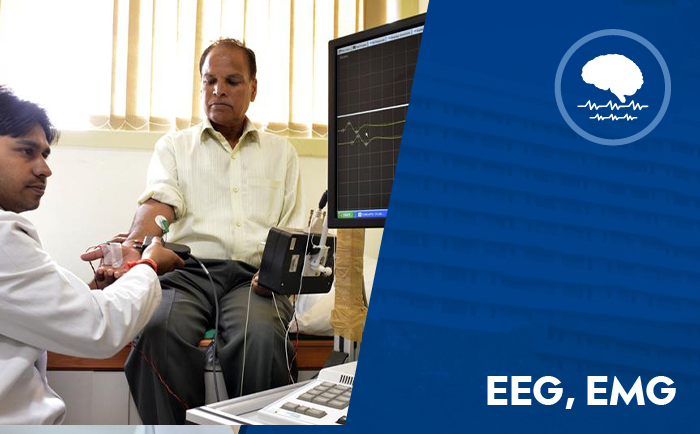
Electroencephalogram (Eeg)
| Location | First Floor, West Wing |
|---|---|
| For Appointment | 0731-4771111 Extn. 2155 |
| Dept. Timings | 10 am to 6 pm |
| List of Consultants | Dr. Atul Taparia, Dr. Alok Mandlia |
Department Of Clinical Neurophysiology (Emg & Ep)
| Location | First Floor, West Wing |
|---|---|
| For Appointment | 0731-4771111 Extn. 2155 |
| Dept. Timings | 10 am to 6 pm |
| List of Consultants | Dr. Atul Taparia, Dr. Alok Mandlia |
The EEG Department in Bombay Hospital Indore started in 2003.The department has two thirty two channel digital machines -
Medelac Profile
Neurosoft
The department is doing routine EEGs and Video EEG (2 hours, 4 hours) and protable Bedside EEGs in ICUs. If required, Sleep Deprivation Recording is also done.
EEG, despite being time consuming, is a painless and safe diagnostic test recommended mainly for Seizure Disorders.
The Electrodiagnostic department at Bombay Hospital Indore is equipped with top of the line equipment. The entire study is performed by doctors trained specially in this branch of medicine.
Electromyography & Nerve Conduction Study (EMG & NCS) also known as Electrodiagnosis, is an assessment of a patient by a physician using a series of tests to establish an accurate diagnosis of a presenting clinical problem that suggests a neuromuscular disorder.
It is an extension of the clinical examination to assess the functional status of the peripheral neuromuscular system and is useful in the diagnosis of Peripheral Neuropathies, Cranial neuropathies, Radiculopathies, Neuromuscular junction effects, Myopathies, Nerve Injuries, Plexopathies and Anterior Horn cell diseases.
It is the only test that examines the function of the nervous tissue being examined and is directed by the clinical impression and the working diagnosis (customized for every patient)
Its uses are as follows –
Accurate localization of the site (Nerve, Plexus, Root, muscle, AHC)
Determining the extent( localised, widespread, Multifocal,)
Identifying the predominant Pathophysiology( Demyelinating, axonal or both)
Objective quantification of the severity (Mild, Moderate, severe)
Documents progress of lesion
Intra operative assessment( for trauma)
Nerve conduction studies- A method of measuring changes in a peripheral nerve by stimulating it electrically and recording the action potential generated.
Sensory nerve conduction studies
Motor nerve conduction studies
Electromyography- A method of studying the electrical activity of a muscle, by placing a needle electrode within it and observing:
The spontaneous activity in the muscle at rest.
The action potentials (Motor Unit Action Potentials) generated by voluntary contraction of the muscle. This is an audio visual diagnosis and is done online.
What should your patient expect? NCS FAQs answered
Nerve Conduction Studies are performed using surface electrodes.
The ‘shocks’ given are in Milli amperes and are quite bearable.
The stimulus is local and does not travel all over the body. Nerve Conduction Studies are always required with a Needle Electrode Examinations.
Can be done very safely even in the new –born & pregnant women.
The Motor conduction stimulus feels like a tap and causes movement of the area being. stimulated.
The Nerve Conduction Studies may be contraindicated in patients with Pacemakers.
What should your patient expect? EMG FAQs answered
The Needle EMG examination is done using fine Disposable.
Electrodes, which are solid pins but thin and very sharp No shocks are given.
The Needle is inserted just into the muscle for few seconds.
The patient is asked to contract the muscle and the activity is picked up by the electrode and displayed on the monitor and over a loud speaker –diagnosis is made on-line.
The number of muscles examined depend upon the working diagnosis.
Needle EMG should be avoided in patients with bleeding disorders, Patients on Anticoagulants and when there is local infection.

